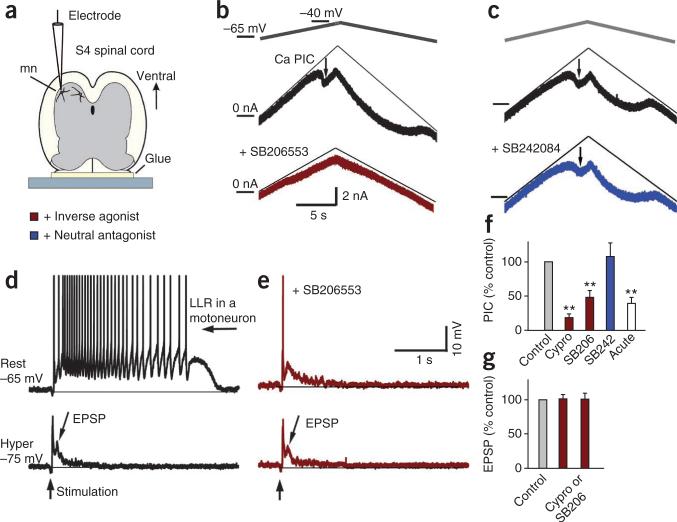Figure 3.
Constitutively active 5-HT2 receptors on motoneurons contribute to Ca2+ PICs underlying spasms. (a,b) Intracellular recording from motoneuron (mn) in whole spinal cord, in vitro. (b) Top, Ca2+ PIC in motoneuron of chronic spinal rat, activated by slowly increasing the membrane potential under voltage-clamp in presence of 2 μM tetrodotoxin (TTX) and quantified at its initial peak, where it produced a downward deflection in the recorded current (thick black plot, at arrow, Ca2+ PIC) relative to the leak current (thin line). Bottom plot, small Ca2+ PIC after SB206553 application (5 μM). (c) Ca2+ PIC in another motoneuron (arrow), which is unaffected by SB242084 application (5 μM). (d) Top, PIC-mediated plateau and sustained firing (LLR) evoked by dorsal root stimulation (3×T; without TTX) in a motoneuron at rest (without injected current; top). Bottom, with a hyperpolarizing bias current to prevent PIC activation, the same stimulation only evoked a polysynaptic EPSP (lower plot). (e) Response of same motoneuron as in d to dorsal root stimulation after application of SB206553 (5 μM), at rest (top) and with a hyperpolarizing bias current (bottom). (f) Group means of Ca2+ PIC (normalized to predrug Ca2+ PIC in chronic spinal rats, control), with SB206553 (SB206; n = 7), cyproheptadine (cypro, 20 μM; n = 16) and SB242084 (SB242; n = 5) in chronic spinal rats and in acute spinal rats (white bar, no drugs, n = 7). (g) Normalized group means of EPSP amplitude (middle bar; control mean 4.4 mV) and duration (right bar, control 480 ms) with inverse agonists cyproheptadine or SB206553 (chronic). **P < 0.01 relative to control, 100%. Error bars represent s.e.m.

